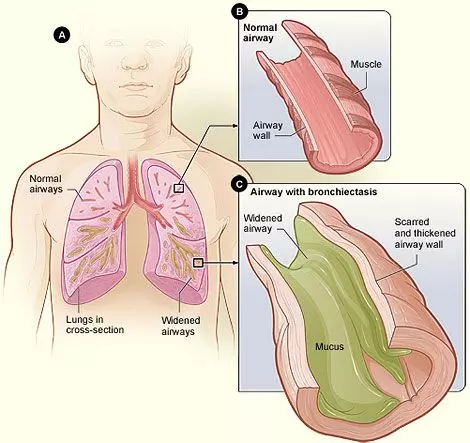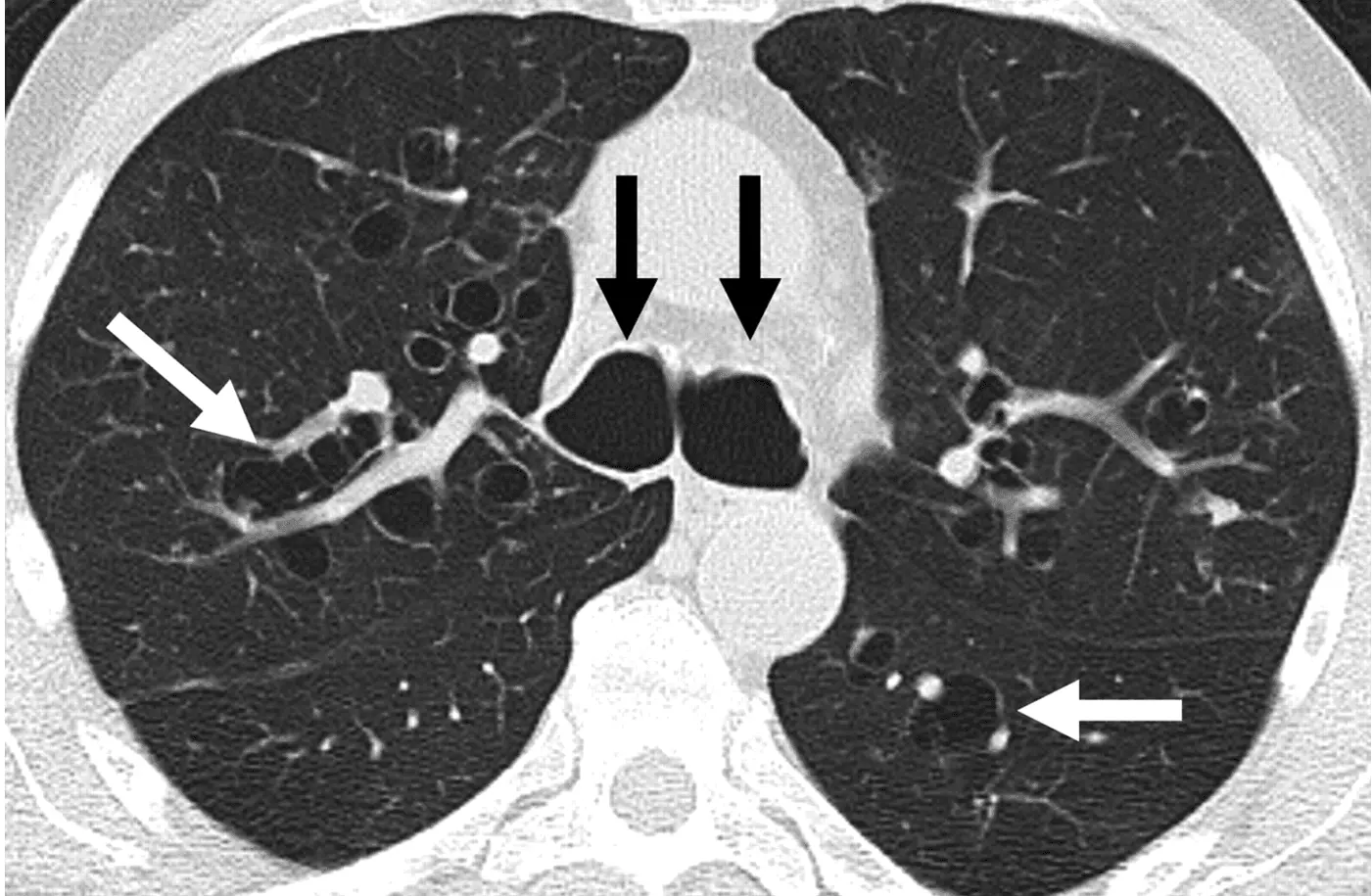Next Lesson - Tuberculosis
Abstract
- Bronchiectasis is characterised by the chronic dilation of one or more bronchi.
- Causes of bronchiectasis include infection, immunodeficiency, mucociliary clearance defects, obstruction, toxic insult, allergic bronchopulmonary aspergillosis and connective tissue disorders.
- Bronchiectasis is investigated via high-resolution CT scan.
- A person with cystic fibrosis will either present with one or more phenotypic characteristics of the condition, or from the positive newborn screen.
- Common complications of cystic fibrosis include persistent respiratory infections, low body weight due to malabsorption, cystic fibrosis related diabetes, and distal intestinal obstruction syndrome.
Core
This article focuses on two chronic lung conditions, bronchiectasis and cystic fibrosis. These conditions are linked, because the genetic condition cystic fibrosis can commonly lead to bronchiectasis. However, it is important to understand the differences between these conditions.
Bronchiectasis is lung condition characterised by the chronic dilation of one or more bronchi. These bronchi exhibit poor mucus clearance, and people with bronchiectasis are therefore predisposed to recurrent or chronic bacterial infection.

Diagram - The difference between healthy bronchi and bronchi found in patients with bronchiectasis
Public Domain Source by National Heart Lung and Blood Institute [Public domain]
Common infectious organisms include Haemophilus influenzae, Pseudomonas aeruginosa, Moraxella catarrhalis, Aspergillus species, Candida species, and Non-tuberculous mycobacteria. It is important to note that this list includes ‘typical’ and ‘atypical’ pathogens when considering the ‘normal’ bacteria to cause infections in the lungs. This relates to the causes of bronchiectasis below: the causes all predispose to infection so allow abnormal pathogens to cause problems.
There are many different causes of bronchiectasis, although in many patients no obvious cause can be found:
- Post-infection – most commonly seen following whooping cough or tuberculosis infections.
- Immunodeficiencies – such as hypogammaglobulinaemia (a condition characterised by low IgG levels), or secondary immunodeficiency (such as HIV infection).
- Mucociliary Clearance Defects – conditions such as cystic fibrosis or primary ciliary dyskinesia.
- Obstruction – by things such a foreign body, tumour or an extrinsic lymph node.
- Toxic Insult – aspiration of acidic gastric contents or occupational smoke inhalation.
- Allergic Bronchopulmonary Aspergillosis – a mixed type I (IgE eosinophilic) and type III (IgG) hypersensitivity reaction that occurs when aspergillus species are breathed in. Unusually, bronchiectasis causes by aspergillosis causes peripheral and central airway dilation.
- Autoimmune Disease – such as rheumatoid arthritis or Sjogren’s Syndrome.
It is important to note that tobacco smoking has not been proven as a cause of bronchiectasis. However, tobacco smoking can worsen pulmonary function, encourage obstruction (e.g. lung cancers) and accelerate the progression of established bronchiectasis.
The most common symptoms of bronchiectasis include:
- Chronic cough
- Daily sputum production which can vary in quantity, consistency, and colour
- Breathlessness on exertion
- Intermittent haemoptysis commonly presenting as red streaks in the sputum
- Chest pain
- Fatigue
- Patients may also experience a wheeze, but this is less common
Bronchiectasis makes up one part of the triad of classical symptoms in two genetic conditions. These are important differential diagnosis to consider when taking a history from a patient with suspected bronchiectasis.
- Young’s Syndrome – a triad of bronchiectasis, chronic sinusitis and reduced fertility in the male. This autosomal recessive condition is characterised by abnormally thick mucus, resulting is stasis of mucus in the lungs and sinuses, and the difficulty of sperm moving through the epididymis.
- Kartagener’s Syndrome – a triad of bronchiectasis, chronic sinusitis and situs inversus. This condition is a subsection of Primary Ciliary Dyskinesia (PCD), where cilia in the body do not move as effectively as they should. Situs inversus (where the organs are arranged as a mirror image of normal) occurs in about 50% of patients with PCD, making Kartagener’s Syndrome the largest contributor to PCD.
The gold standard diagnostic investigation for bronchiectasis is a high resolution CT scan, which will show bronchial dilation to the point where the bronchus is more dilated than the adjacent blood vessel, and bronchial wall thickening. Classically, CT scans of bronchiectasis patients also show the ‘Signet Ring sign’, a term used to describe the shape that a very dilated bronchus and smaller pulmonary artery are seen in very close association. On the image below, it can be seen in the right middle and lower lobes.

Image - CT scan of a patient with bronchiectasis. It shoes widened airways, some of which are indicated by arrows. It also shows the ‘signet ring sign’ with white pulmonary airways in close association to dark, dilated airways
Creative commons source by Mcgfowler [CC BY-SA 4.0 (https://creativecommons.org/licenses/by-sa/4.0)]
Management of bronchiectasis involves treating any underlying cause, physiotherapy and consideration of nebulised saline to encourage mucus clearance, routine sputum samples, creation of a management plan for infective exacerbations, and flu vaccinations.
Daily antibiotics can be considered, especially if the patient regularly cultures Pseudomonas aeruginosa or MRSA in their sputum. Inhaled corticosteroids or bronchodilators can also be considered under guidance of respiratory physicians.
If a patient has an MRC dyspnoea score ≥3 (the patient walks slower than their contemporaries because of breathlessness or stops for breath when walking at their own pace) then pulmonary rehabilitation should be considered to increase exercise tolerance and reduce the number of exacerbations that they have.
An exacerbation of bronchiectasis is defined by a deterioration in three or more key symptoms for at least 48 hours, with key symptoms being a cough, sputum volume and consistency, breathlessness, exercise tolerance, fatigue, and haemoptysis.
Treatments for exacerbations include aerosolised or oral antibiotics, and supportive care like IV fluids if necessary.
Cystic fibrosis (CF) is an autosomal recessive disease, that causes a mutation in the long arm of chromosome 7. This mutation is named the Cystic Fibrosis Transmembrane Conductance Regulator (CFTR) mutation and causes ineffective cell surface chloride transport, making thick, dehydrated body fluids in organs with the mutation. This causes multisystem disease primarily in the respiratory and gastrointestinal system as this is where the CFTR mutation is present.
Cystic fibrosis affects around 10,500 people in the UK (source).
A person with cystic fibrosis will usually present in one of the following ways:
One or more characteristic phenotypic features of the disease: 15-20% of new-born infants with cystic fibrosis will have meconium ileus, in which the bowel is blocked with sticky secretions, causing signs of obstruction (vomiting, abdominal distention, and delay in passing meconium) soon after birth. Over 90% of people with CF will suffer from intestinal malabsorption, which is normally evident in infancy and caused by exocrine pancreatic insufficiency (the pancreatic enzymes are too sticky to do their job). Other characteristics are recurrent chest infections, or infertility in males, although it is unusual to be diagnosed in adulthood.
Positive newborn screen test result: a heelprick blood test is carried out on all newborns in the UK in order to test them for the faulty gene. This is does routinely, but more in depth testing can be performed if the baby has known family members with the disease.
If cystic fibrosis is not diagnosed at birth, it can be diagnosed either through a sweat test, in which there will be an increased sweat chloride concentration (>60 mmol/L) or through the identification of two CF mutations in genotyping.
Common complications of cystic fibrosis include:
Persistent respiratory infections needing aggressive treatment with physiotherapy and antibiotics (which patients often also receive prophylactically). This occurs because the mucus in the lungs of these patients is very viscous, meaning it is hard to cough up. This stasis of mucus predisposes them to infection.
Low body weight or restricted growth in children due to malabsorption from the gastrointestinal tract. Most patients with CF manage this with dietician input, but their malnutrition may result in the need for NG (naso-gastric) or PEG (percutaneous endoscopic gastrostomy) feeding.
Cystic fibrosis related diabetes is a condition that occurs in CF patients when the pancreas does not produce enough insulin because the secretions are too sticky to excrete.
Distal intestinal obstruction syndrome, in which there is a build-up of thickened faeces in the bowel, presenting with a palpable mass in the right iliac fossa.
Further complications are outlined below:
- Lungs – bronchiectasis, pneumothorax, haemoptysis, respiratory failure and allergic bronchopulmonary aspergillosis.
- Upper Respiratory Tract – chronic sinusitis.
- Gastrointestinal System – oesophageal reflux and oesophagitis.
- Hepatobiliary System – chronic liver disease, portal hypertension and gallstones.
- Cardiac System – cardiac failure.
- Musculoskeletal System – arthritis and osteoporosis.
- Reproductive Tract – male infertility due to the absence of vas deferens.
The management of cystic fibrosis is complicated and is led by a cystic fibrosis specialist centre with a multi-disciplinary team. The care is holistic, but mainly focuses on maintaining lung health and nutritional status. Co-morbidities will also be managed. This can include prophylactic antibiotics to prevent infections developing, nebulisers or inhalers to help remove the mucus from the lungs or physiotherapy to encourage mucus clearance.
There is a range of lifestyle advice that can be given to a person with cystic fibrosis:
- Do not smoke.
- Avoid other patients with cystic fibrosis to reduce the risk of cross-infection.
- Avoid other people who have an infection, for example do not visit friends if they have a cold.
- Avoid jacuzzies as they are a known source of Pseudomonas infection.
- Avoid farms as they are a known source of aspergillus infection.
- Have the flu jab and all other scheduled vaccinations.
Patients with CF who want to start a family should also be referred for pre-conceptual councelling. Because CF is an autosomal recessive disease, the patient suffering from CF will have two copies of the faulty gene. This means that they will pass one copy on to all of their children. However, provided that the partner has no copies of the faulty gene (which can be genetically screened for) the children will not have the disease and will only act as carriers.
Edited by: Dr. Maddie Swannack
Reviewed by: Dr. Thomas Burnell
- 8462

